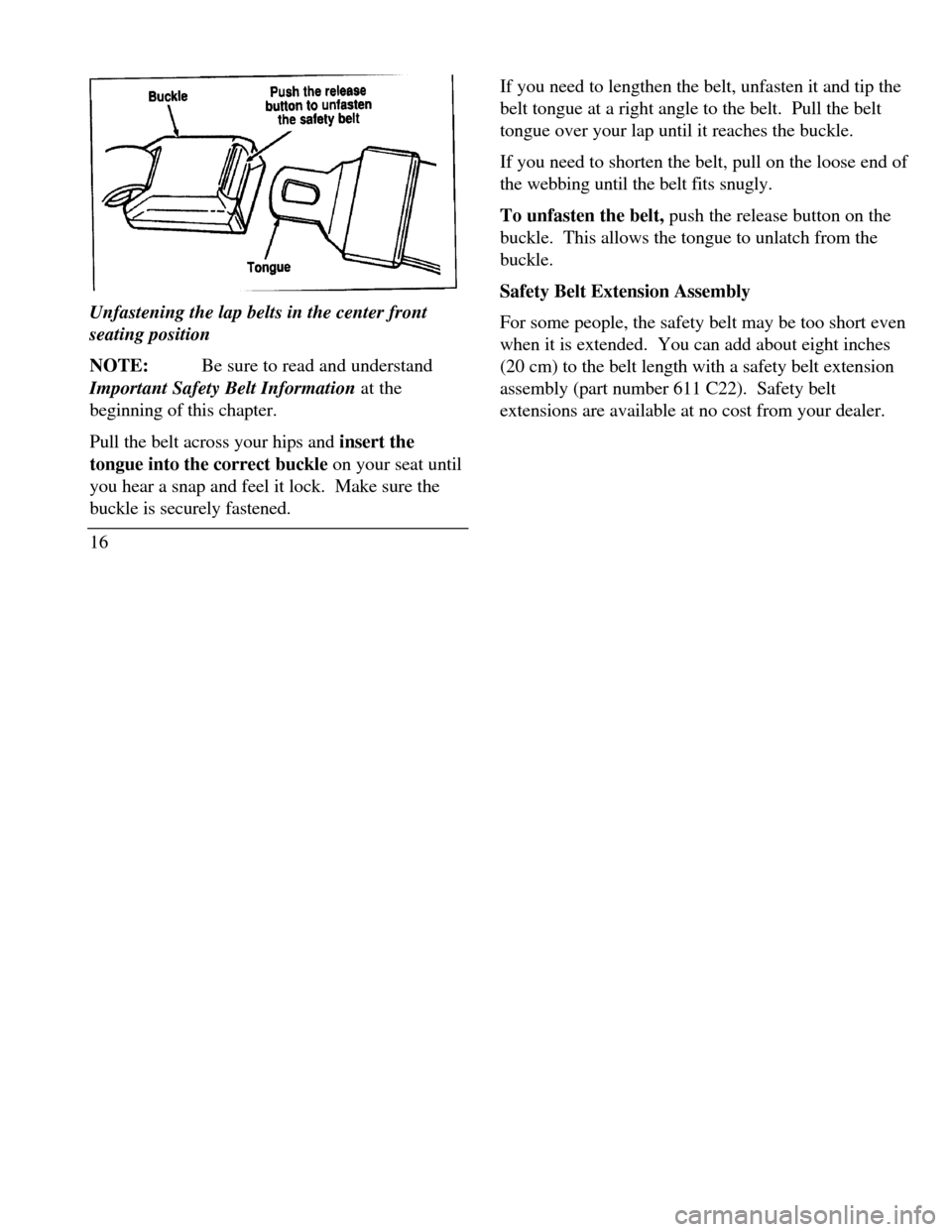Page 20 of 320

Unfastening the lap belts in the center front
seating position
NOTE:Be sure to read and understand
Important Safety Belt Information at the
beginning of this chapter.
Pull the belt across your hips and insert the
tongue into the correct buckle on your seat until
you hear a snap and feel it lock. Make sure the
buckle is securely fastened.
16If you need to lengthen the belt, unfasten it and tip the
belt tongue at a right angle to the belt. Pull the belt
tongue over your lap until it reaches the buckle.
If you need to shorten the belt, pull on the loose end of
the webbing until the belt fits snugly.
To unfasten the belt, push the release button on the
buckle. This allows the tongue to unlatch from the
buckle.
Safety Belt Extension Assembly
For some people, the safety belt may be too short even
when it is extended. You can add about eight inches
(20 cm) to the belt length with a safety belt extension
assembly (part number 611 C22). Safety belt
extensions are available at no cost from your dealer.
Page 41 of 320

9. Check to make sure that the child seat is
properly secured prior to each use. If the
retractor is not locked, repeat steps 6 through
8.
NOTE:To remove the retractor from
automatic lock mode, allow seat belt to retract fully
to its stowed position and the retractor will
automatically switch back to the vehicle sensitive
locking mode for normal adult usage.
Installing a Child Safety, Seat at the
Front Center Seating Position with
Adjustable Lap Belt-
1.Lengthen the lap belt. To lengthen the belt,
hold the tongue so that its bottom is
perpendicular to the direction of webbing
while sliding the tongue up the webbing.
2. Place the child safety seat in the center seating
position.3.Route the tongue and webbing through the
child seat according to the child seat
manufacturer's instructions.
4. Insert the belt tongue into the proper buckle
for the center seating position until you hear
a snap and feel it latch. Make sure the
tongue is m securely fastened to the buckle
by pulling on tongue.
5. Push down on the child seat while pulling on
the loose end of the lap belt webbing to
tighten the belt.
6. Before placing the child into the child seat,
forcibly tilt the child seat from side-to-side
and in forward directions to ensure that the
seat is held securely in place. If the child seat
moves excessively, repeat steps 5 through 6,
or properly install the child seat in a different
seating position.
37
Page 186 of 320

Driving
When to use (Overdrive) (Overdrive) is the usual driving position for an
automatic overdrive transaxle. It works the same
way D (Drive) works, automatically upshifting or
downshifting as the vehicle speeds or slows.
However, (Overdrive) also shifts into a fourth gear
- an overdrive gear - when your vehicle cruises at a
consistent speed for any length of time. This fourth
gear will increase your fuel economy when you travel
at cruising speeds.(Overdrive) may not be appropriate for certain
terrain. If the transaxle shifts back and forth between
third and fourth gears while you are driving on hilly
roads or if your vehicle requires additional power for
climbing hills, shift to D (Drive).When to use D (Drive)
D (Drive) eliminates the excessive shifting
between third and fourth gears that your
vehicle sometimes does when you are traveling
through hilly terrain in Overdrive. It also
gives more engine braking to ml slow your
vehicle on downgrades than Overdrive.
When to use 1 (First)
Use I (First) when added engine braking is
desired when descending steep hills.
The automatic transaxle will shift to the proper
gear to ascend any grade without any need to
shift to I (First).
P (Park)
Always come to a complete stop before you
shift into P (Park). Make sure that the
gearshift is securely latched in P (Park). This
locks the transaxle and prevents the front
wheels from rotating.
183